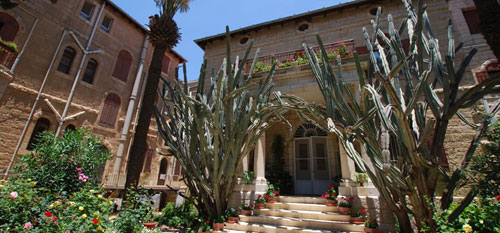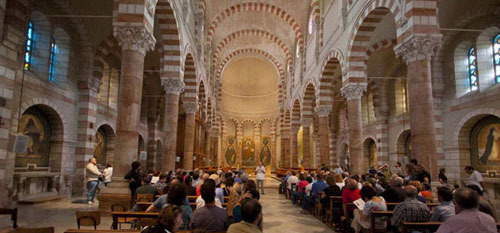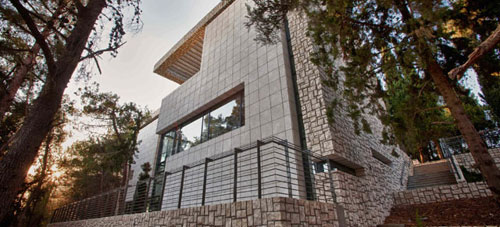One weekend a year, the public can get a free peek inside private houses, urban villas, unique synagogues, architecturally significant public buildings, curious construction sites, plazas and gardens of Jerusalem.
The fifth annual
Houses From Within - Jerusalem took place on November 4-5. A whopping 107 sites were included, some needing advance registration. "Every year, we look for unusual, outstanding places to add to the list," says Aviva Levinson, co-founder of Houses From Within along with her husband, architect Alon Bin Nun.
The couple established the annual event in Tel Aviv-Jaffa and moved on to the capital city. The Israeli tours, which each draw about 80,000 people, are part of a global network of
Open House weekends in cities such as London, Dublin, New York, Chicago, Rome, Barcelona and Melbourne. "Many people have contributed in order to allow us all to discover 'Jerusalem from within' during this weekend, including architects, developers, property owners, institutional administrators and many others who live and breathe the city, including some who devote their time to trying to improve it," says Levinson.
"The architects' community knows this event is a good platform for professional exposure for their own projects or others they know of," adds Levinson, a journalist. "It takes months of organization, but it's fun, and we get to see all the places suggested - even ones that don't end up making the list." The roster of sites grows each year but typically includes many repeat venues. "People like when we have the same sites offered if they didn't manage to get there the year before," Levinson explains.
Following is a sampling of 15 of the tours offered:
1. Villa Gillette, 8 Alkalai Street, Talbiyeh
Designed by architect Khuri Ftasis Spiro in 1926 and renovated this year by Avner Even-Tov, the villa originally was built for the Christian-Arab businessman Elias Gillette and his wife Catherine and has served as a youth center and educational institution. It boasts ornate facades, Armenian ceramics, Art-Deco furnishings and red Moorish decorations on the bow windows and corners.
2. The Jerusalem Center for Near East Studies (Brigham Young University) at the Mount of Olives
Architect David Reznik designed this edifice in 1988 in cooperation with Franklin Fergusson. It's surrounded by a garden containing plants that were common in the biblical period, and nearly every window in the building offers a panoramic view of the Old City. Tours included a brief video, an explanation about the building and a taste of organ music.
3. Mei Naftoach - Lifta Nature Reserve, western outskirts of Jerusalem
Two tours led by guides from the Israel Nature and Parks Authority focused on the rural architecture found in the area, which ranges from the 18th century up to the beginning of the 20th century, and the preservation and development of the green environment surrounding Jerusalem, including the Jerusalem Park development project currently underway.
4. Monastery of St. Charles Borromeo, 12 Lloyd George Street, German Colony
Karl Hermann Imberger designed this monastery in 1893 for the Catholic nuns of the Order of the Grace of St. Charles Borromeo, a 16th century cardinal, as a shelter for the elderly and the needy, including those suffering from Bubonic plague. In 1905, the building was converted into a school for girls, and during World War II it became a sanctuary for 140 German nuns. After the war, the building sheltered Holocaust survivors cared for by the nuns, and in the 1990s it was turned into a hostel for Christian pilgrims.
 Photo by Vardit Zimmerman
Photo by Vardit Zimmerman
5. Yafe Nof Residence, 26 Zichron Tuvia Street, Nachlaot
Architects Roi Alroi and Yoel Brideman worked with homeowner Orit Yafe Nof in 2000 to create a home that offers an updated interpretation of the dense zoning plan for the old central neighborhood of Nachlaot. The house is only five meters wide and is built on the walls of the original one-room structure. A sense of roominess is achieved by solutions such as two-story spaces and bridges that connect its different parts.
6. The Yellin House, Motza Agricultural Settlement
This was the first house built in the Jerusalem suburb of Motza in 1890, and one of the symbols of early agricultural settlement in pre-state Israel. The house was built by Yehoshua and Sarah Yellin, who also purchased and worked the land adjacent to it. Yehoshua initiated the construction of a roadside inn on the ruins of a nearby ancient building, which is now a synagogue. After being neglected for 50 years, the house was recently renovated and restored by the Society for Preservation of Israel Heritage Sites. The vineyard and orchard surrounding it were also replanted.
7. St. Stephen's Dominican Church, Ecole Biblique and Dominican Priory, 6 Nablus Road, East Jerusalem
Designed by a French architect on Byzantine ruins to house the St. Etienne (Stephen) Priory of the Dominican Order, which was inaugurated in 1900, this complex also houses a French academic institute specializing in biblical and archaeological studies. Both buildings are situated in a large garden that stretches across a six-acre area, featuring an impressive collection of archaeological relics and Jewish gravesites from the First Temple period.

Photo by Vardit Zimmerman
8. The Train Tunnel to Jerusalem, western outskirts of Jerusalem
A rare chance to visit the site where the 850-meter railroad tunnel that's part of the future Jerusalem-Tel Aviv line is being excavated. Project managers from Amy Metom Engineers explained the technological challenges created by digging tunnels inside a mountain hundreds of meters in length. Participants, wearing helmets and fluorescent vests, enjoyed an overview of the entire string of tunnels and bridges on the line.
9. The Electric Company Headquarters, 44 HaMelamed Street, Givat Shaul
Visitors viewed the workings of the Electric Company's control room, which oversees the entire Jerusalem district and serves hundreds of thousands of homes and business establishments. The tour also included a brief visit at the "103" hotline center as well as a display of Electric Company equipment such as transformers and utility poles.
10. Schatz House, 3 Bezalel Street, Nachlaot
Built by an unknown architect around 1910, this compound is where renowned
Bezalel Academy of Art founder
Prof. Boris Schatz lived with his wife, Olga Pavzner, and their artistic children, Bezalel and Zohara. Tours were led by Jimmy Levinson, a descendant of the family and the executor of the estate.
11. Histadrut Veterans Tenements, Kiryat Moshe Street and Herzl Boulevard
These tenements were built in the early 1950s as a "kibbutz in the middle of the city" for Histadrut (Trade Union) veterans. Guide Nurit Basel talked about the history of the tenements as well as the ideology that dictated their planning, focusing on how the occupants led their daily lives, based on descriptions taken from Meir Shalev's book In His House in the Desert. Shalev lived in the neighborhood during his childhood.
12. The Syrian-German Orphanage, Schneller Compound, 34 Malchei Yisrael Street
An important historical site in Jerusalem, the orphanage was built as a residence in 1855 by Father Johann Ludwig Schneller, a Lutheran missionary. But its purpose changed quickly, when Schneller rescued nine orphaned boys from a massacre in Lebanon and Syria. It later grew into the largest Protestant educational facility in the Middle East, housing orphans and blind children. In 1948, it was taken over by the Israel Defense Forces. Recently vacated, it is expected to be transformed into housing. The architect Gil Gordon, who designed the compound's preservation plan, recounted the history of the site and presented the highlights of his plan.
13. Herzl Educational Center, Herzl Boulevard
Architect Yoav Molcho gave tours of the building he designed, which is situated in a pine grove on Mount Herzl. The new structure draws its elements from the immediate surroundings and is made entirely of local stone that underwent various kinds of processing, reflecting a novel approach to compliance with the requirement to use Jerusalem stone in local construction projects. The building consists of halls with interactive displays, classrooms, a library and offices dedicated to the study of the
father of modern Zionism, Theodor Herzl.
 Photo by Effi Sameah
Photo by Effi Sameah
14. Jerusalem Robbers Gallery, 93 Jaffa Road
Built in the 1880s, this building served as a residence for faculty members of the former Alliance School, the first vocational school in Jerusalem, which was torn down in 1970. The structure is still a residential building, and also houses a gallery featuring a huge collection of Jerusalem windows taken from homes that were demolished or abandoned. Also on display are dozens of love songs written to the city as well as thousands of photographs that document real estate development in Jerusalem.
15. The Pearl of Hanevi'im, 45 Hanevi'im Street
This guided tour, led by Braidman-Agmon Architects, took place at a construction site of a project that includes a building designated for preservation (the old Yad Sarah building and the historic Benjamin Hostel), a 100-year-old eucalyptus tree, a well with six vaults and a new residential construction project. The goal was to show how architecture can find interesting approaches to a complex situation, such as the municipality's decision to create an elevated public space that allows pedestrians to pass along Hanevi'im Street. The new building's contemporary architectural language is meant as a backdrop to the historic structure.